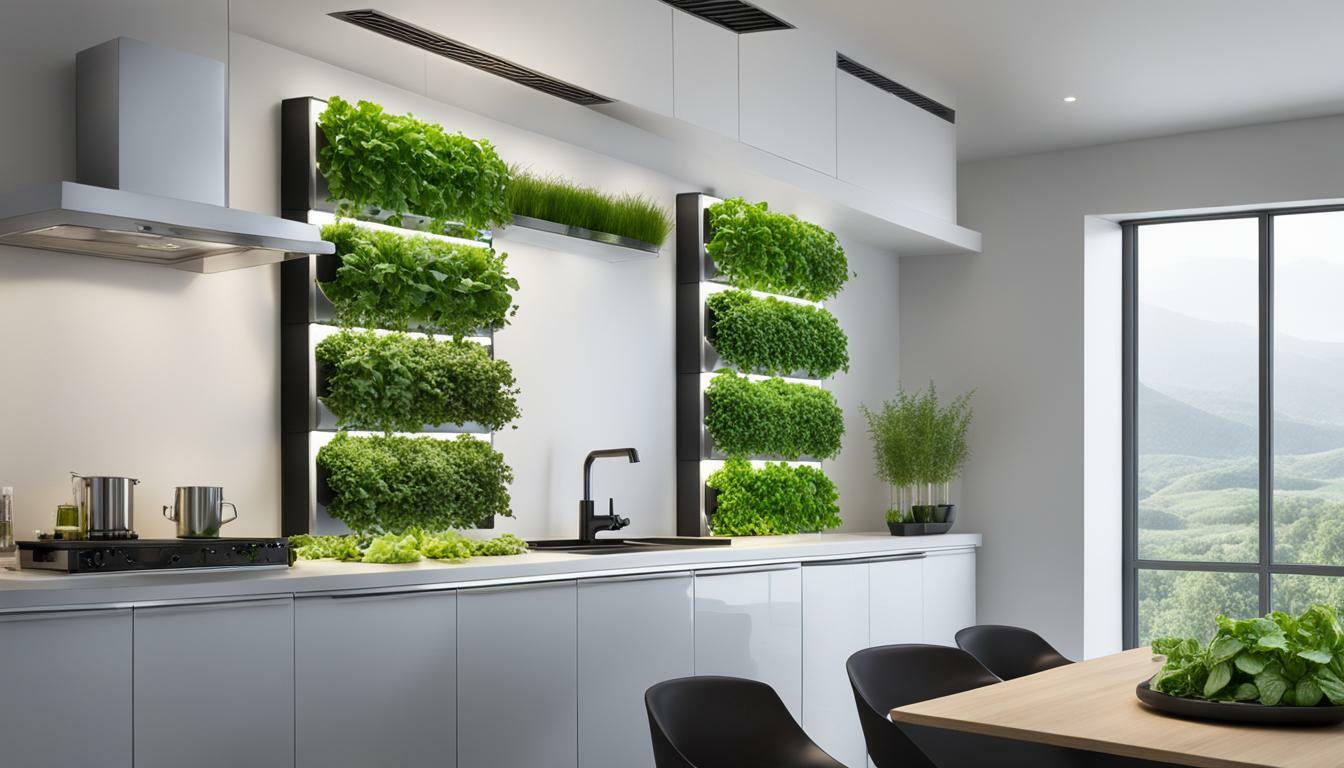A vertical hydroponic herb garden is a game-changer for optimizing your space and enjoying fresh herbs year-round. This innovative gardening method allows you to grow herbs in a vertical structure without the need for soil. Instead, plants are grown using a nutrient-rich water solution, providing them with all the necessary nutrients for healthy growth.
Key Takeaways:
- Vertical hydroponic herb gardens allow you to grow fresh herbs in a space-saving manner.
- These gardens rely on a nutrient-rich water solution instead of soil for plant growth.
- Benefits of vertical hydroponic herb gardens include water efficiency, faster growth, higher yields, and fewer pests.
- Essential components of a hydroponic vertical garden include a vertical structure, growing medium, nutrient solution, and water circulation system.
- Popular hydroponic systems for vertical gardening include Nutrient Film Technique (NFT), Aeroponics, Drip irrigation, and Wick systems.
- Setting up and maintaining a hydroponic vertical garden requires careful assembly, plant preparation, nutrient mix preparation, and regular monitoring and adjustment.
- Tips for successful hydroponic vertical gardening include choosing the right plants, providing adequate lighting, monitoring pH and nutrient levels, maintaining proper air circulation, and keeping the system clean.
- Creative ideas for hydroponic vertical gardens include living walls, room dividers, edible art, hanging gardens, and themed gardens.
- Common challenges in hydroponic vertical gardening include insufficient lighting and the risk of pests and diseases.
- The future of vertical hydroponic herb gardens looks promising, with growing popularity and potential for further advancements in hydroponic systems.
- Vertical hydroponic herb gardens can be purchased from various retailers specializing in hydroponic gardening supplies.
Understanding Hydroponic Vertical Gardens
Hydroponic vertical gardens combine the concepts of hydroponics and vertical gardening to create a unique and efficient way of growing plants without soil. This innovative approach is gaining popularity due to its space-saving design and eco-friendly nature.
Hydroponics is a method of cultivating plants in a water-based nutrient solution, eliminating the need for soil. Vertical gardening, on the other hand, involves growing plants vertically on structures like walls or towers, using limited space effectively.
By marrying these two concepts, hydroponic vertical gardens offer a practical solution for urban dwellers with limited space. They enable the cultivation of a wide variety of plants in apartments, balconies, or small backyards.
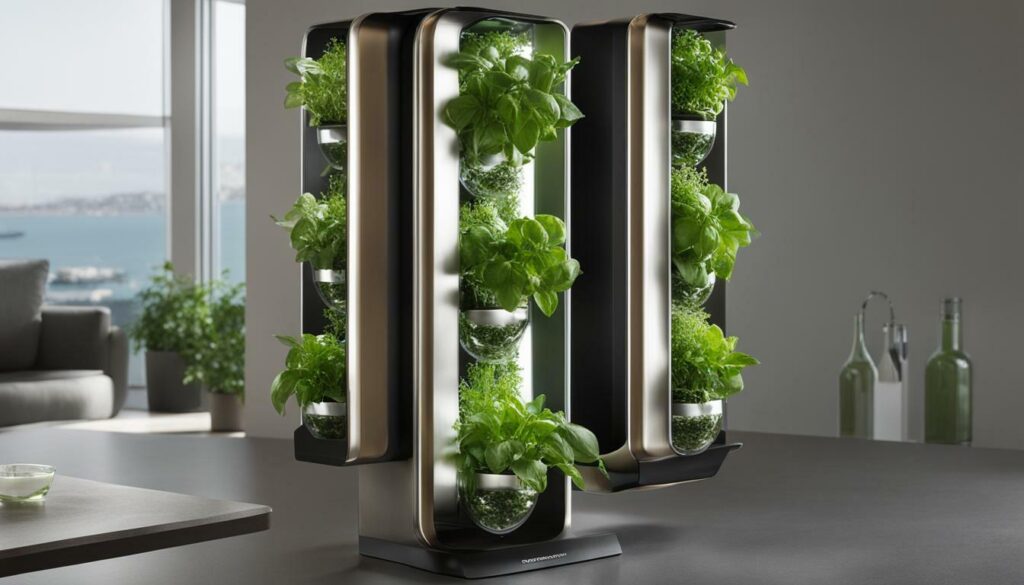
Benefits of Hydroponic Vertical Gardens
Hydroponic vertical gardens provide several advantages over traditional soil-based gardening:
- Space-saving: Vertical gardens maximize space utilization, ideal for urban environments with limited space.
- Water efficiency: Hydroponic systems use up to 90% less water than traditional gardens, making them environmentally friendly.
- Faster growth and higher yields: Plants grown hydroponically often grow faster and produce higher yields due to optimal nutrient delivery.
- Fewer pests and diseases: Hydroponic systems eliminate soil-borne pests and diseases, resulting in healthier plants.
Components of a Hydroponic Vertical Garden
A hydroponic vertical garden typically consists of the following components:
| Component | Description |
|---|---|
| Vertical structure | A sturdy structure that supports the plants and holds the growing medium and water. |
| Growing medium | Alternative media like coco coir or rockwool that anchor the plants and provide support. |
| Nutrient solution | A water-based solution with essential nutrients for plant growth. |
| Water circulation system | A system that ensures a continuous flow of nutrient-rich water to the plants. |
Types of Hydroponic Vertical Garden Systems
Several hydroponic systems can be adapted for vertical gardening. Some popular options include:
- Nutrient Film Technique (NFT): In this system, a thin film of nutrient-rich water flows continuously over the roots of the plants.
- Aeroponics: This system uses a mist or fine spray of nutrient solution to deliver nutrients directly to the plant roots.
- Drip irrigation: Nutrient solution is delivered to each plant via a network of tubes and drip emitters.
- Wick systems: These passive systems use absorbent wicks to transport nutrient solution to the plants’ roots.
Setting Up and Maintaining a Hydroponic Vertical Garden
To set up and maintain a hydroponic vertical garden, follow these steps:
- Assemble the vertical structure according to the manufacturer’s instructions.
- Transplant seedlings or cuttings into the chosen growing medium.
- Mix the nutrient solution according to the instructions provided.
- Establish the water circulation system to ensure a continuous flow of nutrient solution to the plants.
- Monitor and adjust the pH and nutrient levels of the solution as needed.
Tips for Successful Hydroponic Vertical Gardening
Here are some tips to maximize the success of your hydroponic vertical garden:
- Choose plants with shallow root systems that are well-suited for vertical growing.
- Ensure your garden receives sufficient light, either from natural sunlight or artificial grow lights.
- Regularly monitor the pH and nutrient levels of the solution, adjusting as necessary.
- Maintain good air circulation to prevent mold, mildew, and pests.
- Clean your system regularly to prevent algae growth and maintain optimal functioning.
Creative Ideas for Hydroponic Vertical Gardens
Get creative with your hydroponic vertical garden by trying these ideas:
- Create a living wall by transforming an outdoor or indoor wall into a lush green oasis.
- Use a freestanding hydroponic system as a natural room divider in open living spaces.
- Arrange plants in patterns or shapes to create an edible piece of art.
- Suspend small hydroponic containers from the ceiling to create a hanging garden.
- Design your garden around a specific theme, such as a culinary herb garden or a tropical plant display.
Overcoming Common Challenges in Hydroponic Vertical Gardens
While hydroponic vertical gardens offer numerous benefits, they can also present challenges. Here are some common challenges and how to overcome them:
“Insufficient lighting can result in weak growth and poor yields. Ensure your garden receives adequate light, either by positioning it in a sunny area or using artificial grow lights.”
The Future of Vertical Hydroponic Herb Gardens
Vertical hydroponic herb gardens are gaining popularity as urban dwellers seek more sustainable and space-efficient gardening solutions. With advancements in technology and increased awareness of environmental concerns, the future looks promising for vertical hydroponic herb gardens.
Where to Buy Vertical Hydroponic Herb Gardens
If you’re interested in starting your own vertical hydroponic herb garden, you can find a variety of options available for purchase. Check online retailers, specialized gardening stores, or local hydroponic suppliers for vertical hydroponic herb gardens and related supplies.
Conclusion
Vertical hydroponic herb gardens offer a convenient and efficient way to grow plants without soil, making them ideal for urban environments with limited space. By combining the concepts of hydroponics and vertical gardening, these gardens revolutionize traditional gardening methods and offer numerous benefits. Whether you’re a city dweller looking to enhance your living space or a gardening enthusiast seeking a sustainable solution, a vertical hydroponic herb garden can transform your space and revolutionize your gardening experience.
Benefits of Hydroponic Vertical Gardens
Hydroponic vertical gardens offer numerous benefits, including space-saving design, water efficiency, faster growth, higher yields, and reduced risk of pests and diseases.
Space-saving: One of the primary advantages of hydroponic vertical gardens is their ability to maximize space utilization. They are ideal for urban dwellers with limited space, such as apartment balconies or small backyards. By growing plants vertically, you can cultivate more plants in a smaller area.
Water efficiency: Hydroponic systems use up to 90% less water than traditional soil-based gardens, as the water is recirculated and reused in a closed-loop system. This conservation makes hydroponic vertical gardens an environmentally friendly option.
Faster growth and higher yields: Plants grown hydroponically often grow faster and produce higher yields than their soil-grown counterparts. The precise control of nutrients and optimal growing conditions contribute to this increased productivity.
Reduced risk of pests and diseases: Since there is no soil in hydroponic systems, the risk of soil-borne pests and diseases is significantly reduced. Additionally, the vertical design can help deter some pests, making it easier to maintain a healthy garden.
Comparison Table
| Advantages | Hydroponic Vertical Gardens | Traditional Soil-based Gardens |
|---|---|---|
| Space-saving | Maximizes space utilization | Requires larger areas |
| Water efficiency | Uses up to 90% less water | Higher water consumption |
| Faster growth and higher yields | Plants grow faster and produce higher yields | Slower growth and lower yields |
| Reduced risk of pests and diseases | Minimal risk of soil-borne pests and diseases | Higher risk of soil-borne pests and diseases |
Hydroponic vertical gardens offer a sustainable and efficient solution for urban gardening. With their space-saving design, water efficiency, and increased productivity, they are a game-changer for individuals looking to cultivate fresh herbs and vegetables at home.
By harnessing the power of hydroponic systems and vertical gardening, enthusiasts can create a thriving garden in even the smallest of spaces. The controlled environment of hydroponic vertical gardens allows for optimal nutrient delivery and growth, resulting in faster harvests and higher yields. Furthermore, the absence of soil reduces the risk of pests and diseases, making maintenance easier and more enjoyable.
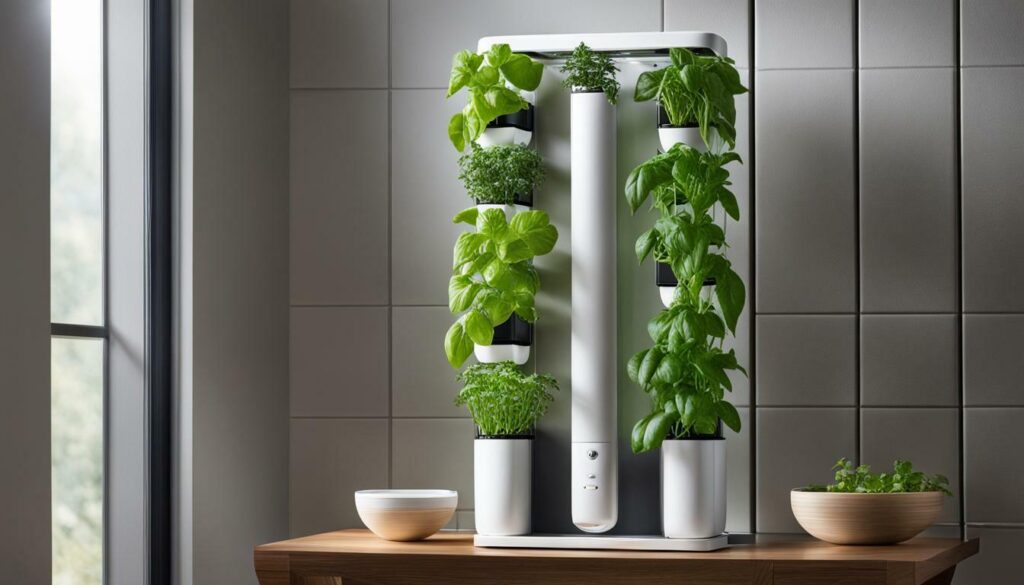
With all of these benefits, it’s no wonder that hydroponic vertical gardens are gaining popularity among urban dwellers and gardening enthusiasts. Whether you’re looking to enhance your indoor herb garden or transform your balcony into a green oasis, a vertical hydroponic garden is the perfect solution.
Components of a Hydroponic Vertical Garden
A typical hydroponic vertical garden consists of a vertical structure, a growing medium, a nutrient solution, and a water circulation system.
The vertical structure serves as the backbone of the garden, providing support for the plants and their growing medium. It can take various forms, such as wall-mounted panels, freestanding towers, or modular systems. The structure should be sturdy and able to withstand the weight of the plants and the water.
The growing medium is used in place of soil and provides support for the plant roots. Commonly used growing media include coco coir, perlite, and rockwool. These materials retain moisture and provide aeration for the roots, ensuring optimal plant growth.
The nutrient solution is a carefully formulated water-based solution that supplies the plants with essential nutrients. It typically contains nitrogen, phosphorus, potassium, and micronutrients. The solution is continually circulated to ensure that the plants receive a consistent supply of nutrients.
The water circulation system includes a pump, reservoir, and tubing. The pump circulates the nutrient solution from the reservoir to the plants, delivering the necessary nutrients. Excess solution is collected and recirculated back to the reservoir, minimizing waste and ensuring efficient water usage.
| Components | Description |
|---|---|
| Vertical Structure | Serves as the support system for plants and provides vertical space for growth |
| Growing Medium | Replaces soil and provides support and moisture retention for plant roots |
| Nutrient Solution | A water-based solution containing essential nutrients for plant growth |
| Water Circulation System | Includes a pump, reservoir, and tubing to deliver and recirculate the nutrient solution |
These components work together to create an efficient and self-contained system for growing plants vertically. By utilizing this setup, hydroponic vertical gardens offer a space-saving and environmentally friendly solution for urban gardening.
Types of Hydroponic Vertical Garden Systems
There are several types of hydroponic systems that can be adapted for vertical gardening, including the Nutrient Film Technique (NFT), aeroponics, drip irrigation, and wick systems. Each system has its own unique characteristics and benefits.
Nutrient Film Technique (NFT)
The NFT system uses a thin film of nutrient-rich water that continuously flows over the roots of the plants. The plants are held in slanted channels, allowing the nutrient solution to flow over the roots and provide the necessary nutrients and oxygen. This system is particularly suitable for growing leafy greens and herbs.
Aeroponics
Aeroponic systems deliver nutrients and water to the roots of the plants through a mist or fine spray. The plants are suspended in air, with their roots exposed, allowing for maximum oxygenation. This method promotes rapid growth and high yields, making it ideal for a wide range of crops.
Drip Irrigation
In a drip irrigation system, a nutrient solution is delivered to each plant through a network of tubes and drip emitters. This controlled delivery ensures that each plant receives the necessary amount of nutrients and water. Drip irrigation is a versatile system that can be adapted for various types of plants and is commonly used in commercial hydroponic farming.
Wick Systems
Wick-based vertical gardens use a passive system where the nutrient solution travels from a reservoir to the plants’ roots through absorbent wicks. The wicks draw up the nutrient solution, providing a constant supply of water and nutrients to the plants. Wick systems are simple and low-maintenance, making them suitable for small-scale home gardens.
Each type of hydroponic system has its own advantages and considerations. It’s important to choose the system that best suits your needs and the type of plants you wish to grow. Experimenting with different systems can help you find the most efficient and productive method for your vertical hydroponic garden.
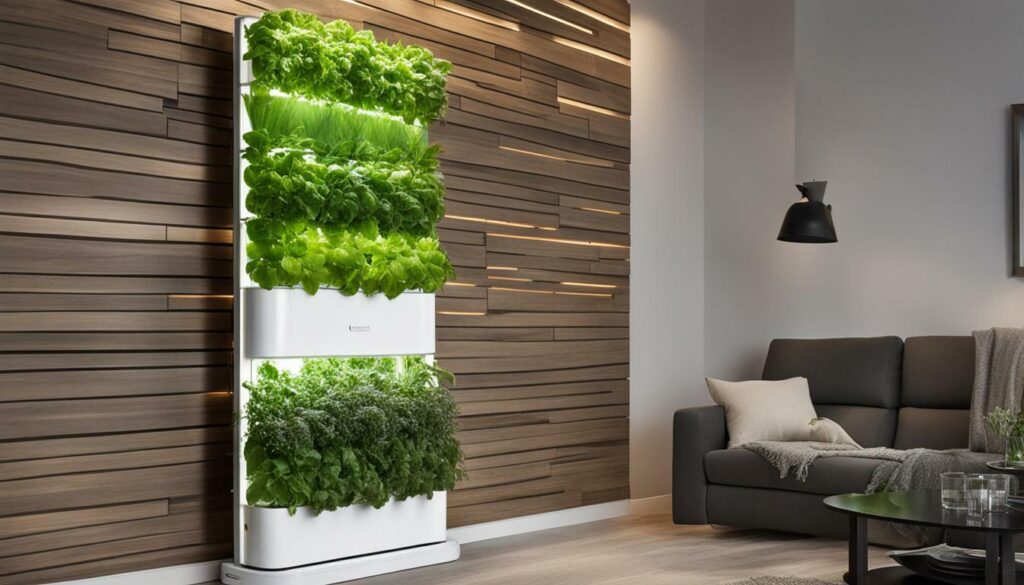
Setting Up and Maintaining a Hydroponic Vertical Garden
Once you’ve chosen your preferred hydroponic system, follow these steps to set up and maintain your vertical garden.
Step 1: Assemble the structure: Set up your vertical structure according to the manufacturer’s instructions. Ensure it’s secure and can support the weight of the plants, growing medium, and water.
Step 2: Prepare the plants: Transplant seedlings or cuttings into the growing medium, taking care not to damage the roots. Gently insert the plants into the vertical structure.
Step 3: Mix the nutrient solution: Follow the instructions on your chosen nutrient mix, ensuring the appropriate concentration for your plants’ needs.
Step 4: Establish the water circulation system: Connect your pump, tubing, and reservoir to create a closed-loop system that delivers the nutrient solution to your plants.
Step 5: Monitor and adjust: Regularly check the pH and nutrient levels of your solution and make adjustments as needed. Prune and harvest your plants as necessary to maintain optimal growth.
Tips for Successful Hydroponic Vertical Gardening
- Choose the right plants: Opt for plants with shallow root systems, such as leafy greens, herbs, and small fruiting plants like strawberries.
- Provide adequate lighting: Ensure your garden receives sufficient sunlight, or use grow lights if you’re growing indoors.
- Monitor pH and nutrient levels: Regularly check and adjust the pH and nutrient concentration of your solution to maintain optimal plant growth.
- Maintain proper air circulation: Good airflow helps prevent mold, mildew, and pests.
- Keep your system clean: Regularly clean your reservoir, tubing, and other components to prevent algae growth and maintain optimal functioning.
Creative Ideas for Hydroponic Vertical Gardens
Hydroponic vertical gardens can be both functional and aesthetically pleasing. Here are some creative ideas to make your garden stand out:
- Living walls: Transform an outdoor or indoor wall into a lush, green oasis with a hydroponic vertical garden.
- Room dividers: Use a freestanding hydroponic system to create a natural room divider in open living spaces.
- Edible art: Arrange your plants in patterns or shapes to create an edible piece of art.
- Hanging gardens: Suspend small hydroponic containers from the ceiling to create a hanging garden.
- Themed gardens: Design your garden around a specific theme, such as a culinary herb garden, a salad garden, or a tropical plant display.
Overcoming Common Challenges in Hydroponic Vertical Gardens
Like any gardening method, hydroponic vertical gardens may face challenges that can hinder their success. One common issue is insufficient lighting, which can cause weak growth and poor yields. To address this, ensure your garden receives adequate sunlight or invest in suitable grow lights. Additionally, maintaining proper pH and nutrient levels, as well as managing airflow and cleanliness, can help prevent common issues such as nutrient deficiencies, pests, and diseases.
The Future of Vertical Hydroponic Herb Gardens
The popularity of vertical hydroponic herb gardens is on the rise, and their future potential is promising. As urban spaces become more limited, vertical gardening offers a solution for maximizing plant cultivation in smaller areas. Additionally, the eco-friendly and resource-efficient nature of hydroponic systems makes them an appealing choice for sustainable urban living. With advancements in technology and continuous research on optimizing vertical hydroponic gardening methods, we can expect to see further innovations and increased adoption of this space-saving gardening technique.
Where to Buy Vertical Hydroponic Herb Gardens
If you’re interested in starting your own vertical hydroponic herb garden, there are various options for purchasing vertical hydroponic systems and related supplies. You can find a wide range of products from online retailers specializing in hydroponics and gardening supplies. Additionally, local gardening stores, nurseries, and home improvement centers may offer vertical hydroponic herb gardens or the necessary components to create your own. Be sure to compare prices, read customer reviews, and choose a reputable supplier to ensure the quality and effectiveness of your vertical hydroponic herb garden.
Conclusion: Vertical hydroponic herb gardens provide an innovative and efficient way to cultivate plants in limited spaces, such as urban environments. With the benefits of space-saving design, water efficiency, and faster growth, hydroponic vertical gardens offer a sustainable solution for home herb gardening. By following the necessary steps for setup and maintenance, along with implementing helpful tips and creative ideas, you can enjoy the rewards of a flourishing hydroponic vertical garden. Embrace this modern gardening technique and revolutionize your space with a vertical hydroponic herb garden.
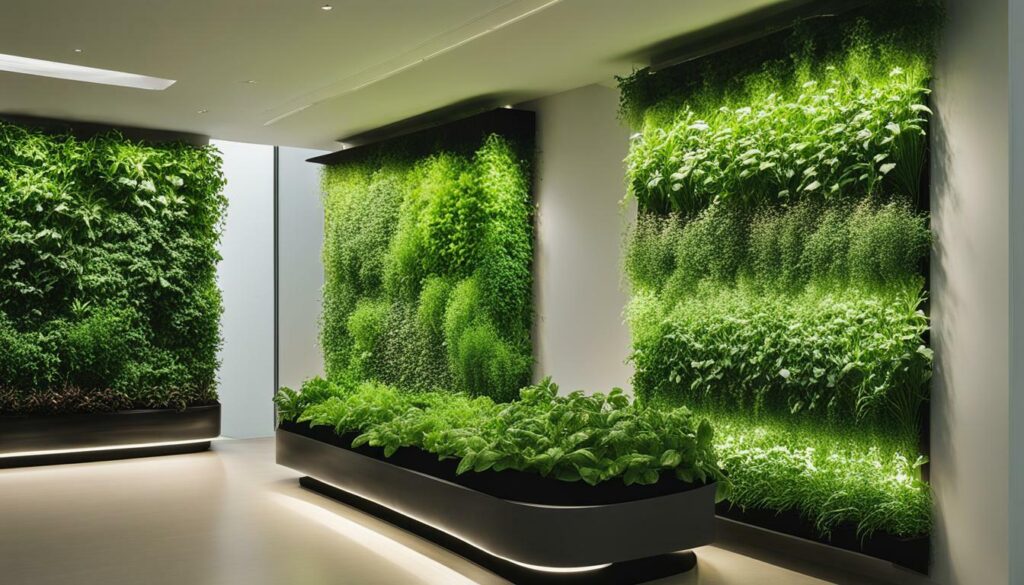
| Vertical Hydroponic Herb Garden | Advantages |
|---|---|
| Space-saving design | Maximizes limited space for urban dwellers |
| Water efficiency | Uses up to 90% less water than soil-based gardens |
| Faster growth and higher yields | Optimal growing conditions contribute to increased productivity |
| Fewer pests and diseases | Reduces the risk of soil-borne pests and diseases |
| Easy setup and maintenance | Follow step-by-step instructions for successful gardening |
Tips for Successful Hydroponic Vertical Gardening
To ensure the success of your hydroponic vertical garden, consider these tips:
- Choose the right plants: Opt for plants with shallow root systems, such as leafy greens, herbs, and small fruiting plants like strawberries. These plants are well-suited for vertical gardening and will thrive in a hydroponic system.
- Provide adequate lighting: Ensure your garden receives sufficient sunlight, or use grow lights if you’re growing indoors. Plants need the right amount of light for photosynthesis and healthy growth.
- Monitor pH and nutrient levels: Regularly check and adjust the pH and nutrient concentration of your solution to maintain optimal plant growth. This will ensure that plants receive the necessary nutrients for healthy development.
- Maintain proper air circulation: Good airflow helps prevent the buildup of excess moisture and reduces the risk of mold, mildew, and pests. Use fans or natural ventilation to keep the air moving around your plants.
- Keep your system clean: Regularly clean your reservoir, tubing, and other components to prevent algae growth and ensure the smooth functioning of your hydroponic system. This will help maintain the health of your plants and prevent clogs or blockages in the system.
By following these tips, you can maximize the success of your hydroponic vertical garden and enjoy a bountiful harvest of fresh, homegrown herbs and vegetables.
Table: Recommended Plants for Hydroponic Vertical Gardening
| Plant Type | Recommended Varieties |
|---|---|
| Leafy Greens | Lettuce, Spinach, Kale, Swiss Chard |
| Herbs | Basil, Mint, Cilantro, Parsley, Thyme |
| Small Fruiting Plants | Strawberries, Cherry Tomatoes, Peppers |
Remember to choose plants that have similar growth requirements and consider the available space and lighting conditions in your vertical garden when selecting your plant varieties. With proper care and attention, your hydroponic vertical garden will thrive and provide you with a fresh and sustainable source of herbs and vegetables.
“Hydroponic vertical gardens offer a space-saving solution for urban dwellers, allowing them to grow fresh herbs and vegetables in limited areas. By following these tips, you can create a successful hydroponic vertical garden in your own home.”
– Hydroponic Gardening Expert
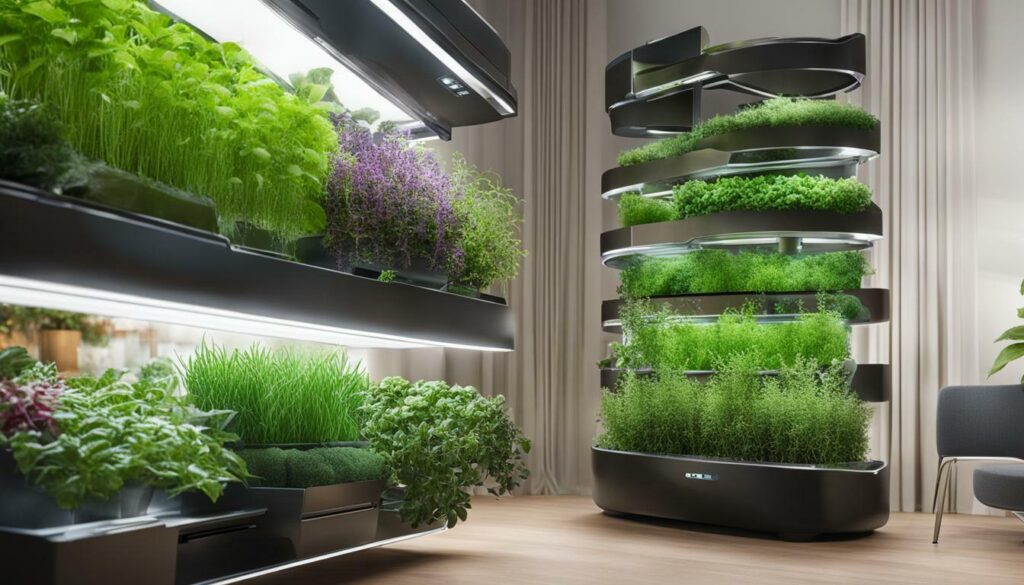
For more inspiration and ideas on how to create a beautiful and productive hydroponic vertical garden, explore our wide range of indoor gardening products and accessories. Start your own indoor herb garden today and enjoy the benefits of homegrown, pesticide-free produce all year round.
Creative Ideas for Hydroponic Vertical Gardens
Get creative with your hydroponic vertical garden by transforming walls into living green spaces, using freestanding systems as room dividers, creating edible art with plant arrangements, or suspending small containers from the ceiling for a hanging garden. There are endless possibilities for designing unique and visually appealing hydroponic vertical gardens. Here are some creative ideas to inspire your own garden:
Living Walls
Transform an outdoor or indoor wall into a lush, green oasis with a hydroponic vertical garden. Use a variety of plants and arrange them in a way that creates a visually striking display. You can choose plants with different textures, colors, and sizes to add depth and visual interest to your living wall.
Room Dividers
Use freestanding hydroponic systems to create natural room dividers in open living spaces. These systems can be placed strategically to separate different areas of a room while also providing a green and refreshing atmosphere. Choose plants that can thrive indoors and create a natural barrier between different spaces.
Edible Art
Arrange your plants in patterns or shapes to create an edible piece of art. Use herbs, edible flowers, and small fruiting plants to design unique and visually appealing arrangements. With careful planning and creative vision, you can turn your hydroponic vertical garden into a living work of art that also provides fresh and delicious ingredients for your meals.
Hanging Gardens
Suspend small hydroponic containers from the ceiling to create a hanging garden. This is especially useful for small spaces where floor or wall space is limited. By hanging your plants, you can maximize vertical space and create a stunning visual display. Use cascading plants or trailing vines to add drama and interest to your hanging garden.
Themed Gardens
Design your hydroponic vertical garden around a specific theme to create a cohesive and visually striking display. For example, you can create a culinary herb garden with a variety of herbs commonly used in cooking. Alternatively, you can create a salad garden with different types of lettuces, spinach, and other leafy greens. The theme possibilities are endless and can be tailored to your personal preferences and tastes.
Remember to experiment and have fun with your hydroponic vertical garden. Let your creativity soar and create a unique and visually appealing garden that enhances your living space.
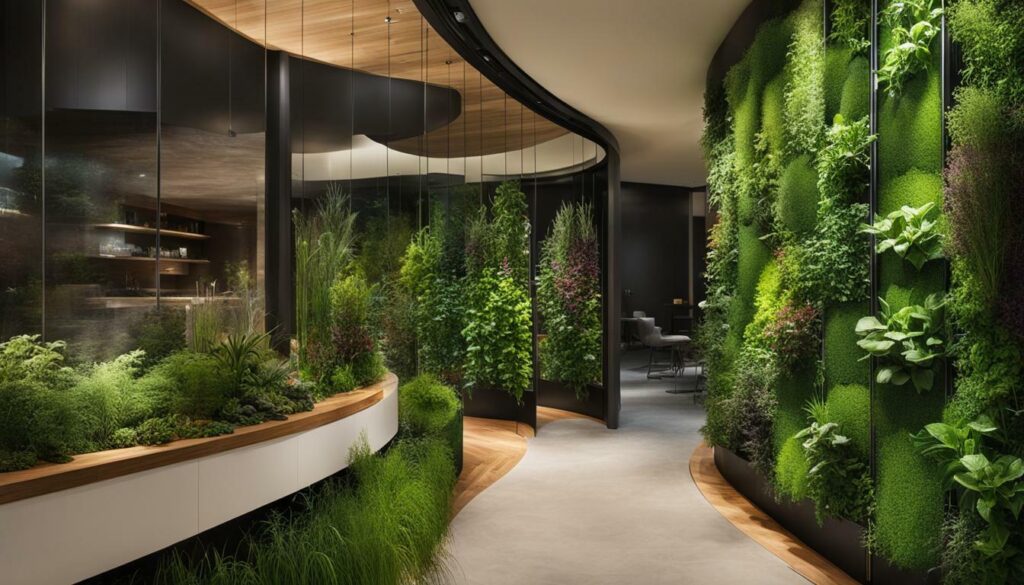
| Advantage | Description |
|---|---|
| Space-saving | Vertical gardens maximize space utilization, making them ideal for urban dwellers with limited space. |
| Water efficiency | Hydroponic systems use up to 90% less water than traditional soil-based gardens, making them environmentally friendly. |
| Faster growth and higher yields | Plants grown hydroponically often grow faster and produce higher yields compared to soil-grown plants due to optimal nutrient control. |
| Fewer pests and diseases | Hydroponic systems reduce the risk of soil-borne pests and diseases, making it easier to maintain a healthy garden. |
“The possibilities for creative and visually appealing hydroponic vertical gardens are endless. Let your imagination run wild and design a garden that reflects your personal style and taste.”
With these creative ideas and the benefits of hydroponic vertical gardening, you can revolutionize your space and enjoy the beauty and functionality of a thriving vertical garden.
Overcoming Common Challenges in Hydroponic Vertical Gardens
Like any gardening method, hydroponic vertical gardens may face challenges such as insufficient lighting or pest control, but with proper care and attention, these challenges can be overcome. Here are some tips to help you address these common challenges and ensure the success of your hydroponic vertical garden:
1. Lighting: Adequate lighting is crucial for the growth and development of plants in a hydroponic vertical garden. If you are growing indoors, ensure that your plants receive sufficient artificial light, such as fluorescent or LED grow lights. Position the lights at the appropriate distance and angle to provide uniform coverage to all plants.
2. Pest Control: While hydroponic systems reduce the risk of soil-borne pests and diseases, other pests like aphids, whiteflies, or spider mites can still affect your plants. Implement preventive measures such as regularly inspecting your plants, using sticky traps, and maintaining proper airflow to deter pests. If an infestation occurs, consider using organic pest control methods or introducing beneficial insects like ladybugs.
3. Nutrient Balance: Maintaining the correct nutrient balance is essential for healthy plant growth in hydroponic vertical gardens. Regularly monitor the nutrient levels in your water solution and adjust accordingly. Use a high-quality nutrient mix specifically formulated for hydroponics and follow the manufacturer’s instructions for optimal dosages.
Tip:
A pH imbalance can also affect nutrient absorption by plants. Monitor the pH levels of your water solution and adjust using pH up or down solutions to maintain a pH range suitable for your plants.
| Challenge | Solution |
|---|---|
| Insufficient Lighting | Ensure plants receive adequate artificial light, such as fluorescent or LED grow lights positioned at the appropriate distance and angle. |
| Pest Control | Implement preventive measures like regular inspection, sticky traps, and maintaining proper airflow. Consider organic pest control methods or beneficial insects. |
| Nutrient Balance | Monitor nutrient levels regularly and adjust as needed. Use a high-quality nutrient mix formulated for hydroponics and maintain proper pH levels. |
By addressing these common challenges and providing the optimal conditions for your hydroponic vertical garden, you can ensure healthy plant growth and maximize your harvests.
The Future of Vertical Hydroponic Herb Gardens
As more people embrace urban gardening and sustainable living, the popularity of vertical hydroponic herb gardens is expected to continue growing, with advancements in technology and design enhancing their efficiency and accessibility. These innovative gardens revolutionize the way we grow plants by eliminating the need for soil and utilizing a nutrient-rich water solution. By combining hydroponics with vertical gardening, these systems maximize space utilization and offer numerous benefits over traditional soil-based gardening.
Vertical hydroponic herb gardens are particularly well-suited for urban environments where space is limited. With the ability to grow plants vertically on walls or in freestanding towers, these gardens allow city dwellers to cultivate herbs and other plants even in small balconies or backyards. This space-saving design is convenient for those living in apartments or houses with limited outdoor areas.
Moreover, vertical hydroponic gardens are highly water-efficient, using up to 90% less water than traditional soil-based gardens. The water is recirculated and reused in a closed-loop system, reducing water waste and making these gardens environmentally friendly. With the increasing concerns over water scarcity and the need for sustainable gardening practices, vertical hydroponic gardens provide a promising solution.
In addition to their water efficiency, vertical hydroponic herb gardens offer faster growth and higher yields compared to traditional gardening methods. By precisely controlling the nutrient levels and environmental conditions, plants can thrive and produce more in a shorter period. This accelerated growth is especially valuable for urban gardeners who want to enjoy fresh herbs, vegetables, and flowers throughout the year.
| Advantages of Vertical Hydroponic Herb Gardens |
|---|
| Space-saving design |
| Water efficiency |
| Faster growth and higher yields |
| Reduced risk of pests and diseases |
Setting up and maintaining a vertical hydroponic herb garden may require some initial effort and investment, but the long-term benefits outweigh the challenges. With proper care and maintenance, these gardens can provide a continuous supply of fresh and nutritious herbs and plants, enhancing the overall quality of urban living.
Inspiring Ideas for Vertical Hydroponic Gardens
Vertical hydroponic gardens offer endless possibilities for creative and visually appealing designs. Here are some inspiring ideas to elevate your vertical garden:
- Create a living wall by transforming an outdoor or indoor wall into a lush green oasis.
- Use a freestanding hydroponic system as a natural room divider in open living spaces.
- Arrange plants in patterns or shapes to create an edible piece of art.
- Suspend small hydroponic containers from the ceiling to create a hanging garden.
- Design your garden around a specific theme, such as a culinary herb garden or a tropical plant display.
These creative ideas not only make your vertical hydroponic garden visually stunning but also add a touch of nature and greenery to your living space.
Overcoming Challenges in Vertical Hydroponic Gardens
While vertical hydroponic gardens offer numerous benefits, they are not without challenges. Common challenges that may arise include maintaining proper lighting, managing nutrient levels, and ensuring proper air circulation. However, with careful attention and the right techniques, these challenges can be overcome to create a thriving vertical hydroponic garden.
Proper lighting is crucial for the growth of plants in vertical hydroponic gardens. Adequate sunlight or the use of artificial grow lights is essential to provide plants with the necessary light energy for photosynthesis. Monitoring and adjusting nutrient levels in the water solution is also critical to ensure plants receive the right balance of essential nutrients for optimal growth. Additionally, ensuring proper air circulation helps prevent the growth of mold, mildew, and pests.
The Future Potential of Vertical Hydroponic Herb Gardens
The future of vertical hydroponic herb gardens is promising, with ongoing advancements in technology and design. As more research is conducted and innovations are made, these gardens are expected to become even more efficient and accessible. There is potential for the development of smarter and automated systems that make vertical hydroponic gardening easier for urban dwellers.
Furthermore, vertical hydroponic gardens have the potential to contribute to sustainable food production and address food security challenges in urban areas. By maximizing space utilization and water efficiency, these gardens can help alleviate the strain on traditional agricultural systems and provide fresh and nutritious food locally.
As the demand for locally sourced and pesticide-free food increases, vertical hydroponic herb gardens offer a viable solution for urban communities. With their space-saving design, water efficiency, and ability to produce high yields, these gardens have the potential to enhance urban living and promote sustainable food production for a healthier future.
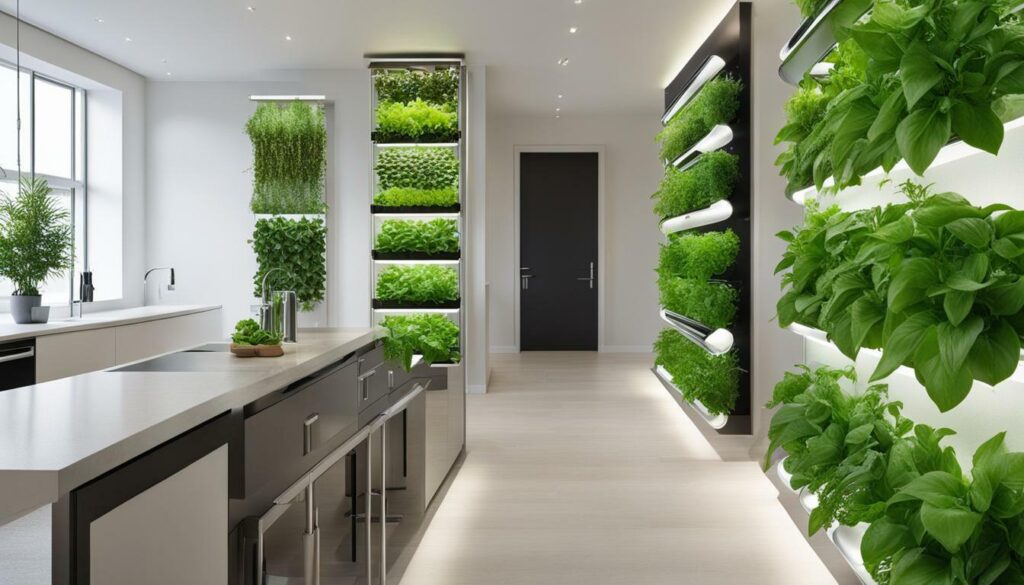
Where to Buy Vertical Hydroponic Herb Gardens
If you’re ready to start your own vertical hydroponic herb garden, there are various online and local retailers that offer a wide range of options to suit your needs. Whether you’re a seasoned gardener or a beginner, these retailers provide everything you need to revolutionize your space and grow fresh herbs all year round.
Online Retailers
1. Ahopegarden – Ahopegarden offers a variety of vertical hydroponic herb garden kits and accessories. Their products are designed for easy setup and maintenance, making it simple for anyone to start growing their own herbs at home. With their high-quality and innovative solutions, Ahopegarden is a trusted source for vertical hydroponic gardening.
2. Gardyn – Gardyn is another reputable online retailer that specializes in vertical hydroponic gardening systems. Their vertical gardens are sleek and modern, making them a stylish addition to any home. Gardyn offers a subscription-based service that delivers fresh plant pods directly to your door, ensuring a constant supply of herbs for your everyday cooking needs.
3. Indoor Farmer – Indoor Farmer is a one-stop-shop for all your hydroponic gardening needs. They offer a wide range of vertical hydroponic systems, from compact countertop gardens to larger freestanding towers. With their extensive selection and expert customer service, Indoor Farmer is a reliable choice for those looking to venture into the world of hydroponic gardening.
Local Retailers
1. Home Improvement Stores – Many local home improvement stores, such as Home Depot and Lowe’s, carry a variety of hydroponic gardening supplies. Check their garden section for vertical hydroponic systems, growing media, and nutrient solutions. These stores often have knowledgeable staff who can assist you in choosing the right products for your needs.
2. Hydroponic Supply Stores – Look for specialized hydroponic supply stores in your area. These stores cater specifically to hydroponic gardeners and offer a wide range of equipment, including vertical hydroponic systems. They can provide expert advice and guidance to help you create a successful hydroponic herb garden.
3. Farmers Markets – Visit your local farmers market for a chance to connect with local growers and hydroponic farmers. They may have their own vertical hydroponic gardens and be able to offer valuable insights and recommendations. You may even find small-scale vertical hydroponic systems or starter kits available for purchase.
When purchasing a vertical hydroponic herb garden, be sure to consider factors such as the size of the system, ease of use, and customer reviews. Compare prices and features to find the best option for your space and needs. With the right vertical hydroponic herb garden, you can enjoy the benefits of fresh, homegrown herbs throughout the year.
Table: Comparison of Online Retailers
| Retailer | Specialization | Product Range | Subscription Service | |—————–|———————————|———————————|———————-| | Ahopegarden | Vertical hydroponic gardening | Kits, accessories | No | | Gardyn | Vertical hydroponic gardening | Systems, plant pods | Yes | | Indoor Farmer | Hydroponic gardening supplies | Systems, growing media, nutrients | No | Note: Prices and availability may vary. Please visit the retailers’ websites for the most up-to-date information.Quote:
“A vertical hydroponic herb garden is not only a practical solution for small spaces, but it also adds a touch of greenery and freshness to any indoor or outdoor area.” – Ahopegarden
Start your vertical hydroponic herb garden and enjoy the convenience of having fresh herbs at your fingertips. Whether you choose to purchase online or visit local retailers, the possibilities for transforming your space with a vertical hydroponic garden are endless.
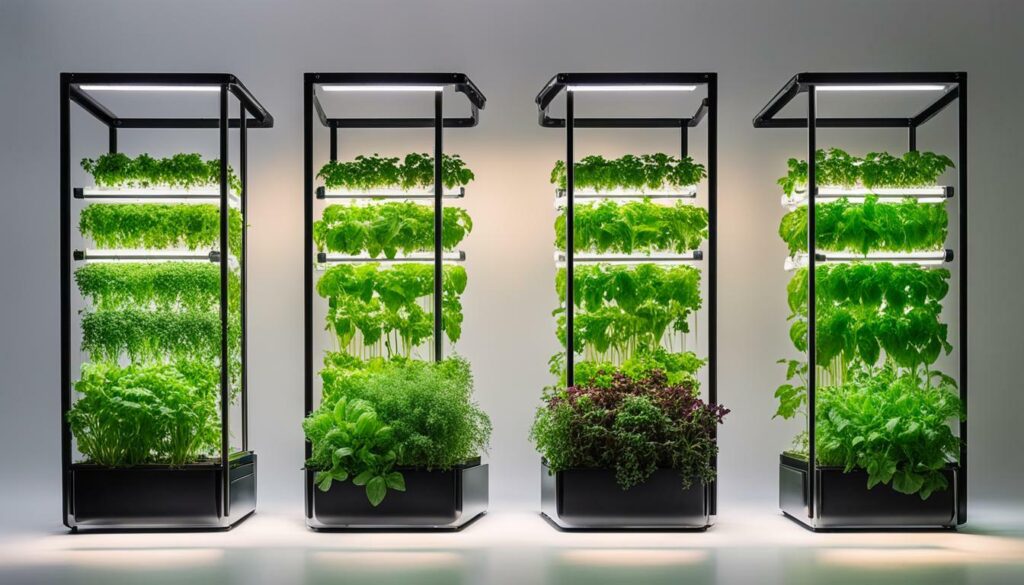
Conclusion
In conclusion, a vertical hydroponic herb garden is a practical and efficient solution for urban dwellers looking to optimize their space, improve air quality, and enjoy the fresh taste of homegrown herbs year-round.
By revolutionizing your space with a vertical hydroponic herb garden, you can overcome the limitations of traditional soil-based gardening and maximize the use of limited space.
With hydroponic vertical gardens, you can enjoy the benefits of water efficiency, faster growth and higher yields, and a reduced risk of pests and diseases. These gardens also provide a visually appealing addition to your home or outdoor space, allowing you to get creative with design options.
Setting up and maintaining a hydroponic vertical garden is relatively simple, and with the right components and system, you can easily grow a variety of herbs and plants. By following a few tips for successful hydroponic vertical gardening, you can ensure the long-term success of your garden.
The future of vertical hydroponic herb gardens is promising, as more and more people recognize the advantages of this innovative gardening method. As urban living continues to expand and green spaces become limited, vertical hydroponic gardens offer a sustainable solution to growing fresh herbs and plants in any environment.
If you’re interested in starting your own vertical hydroponic herb garden, there are various options available for purchasing vertical hydroponic systems and related supplies. Take the time to research and find the best option for your needs and budget.
Overall, a vertical hydroponic herb garden provides a convenient and efficient way to enjoy the benefits of gardening, even in limited spaces. Whether you’re a seasoned gardener or new to the world of hydroponics, a vertical herb garden is a worthwhile investment that can enhance your urban living experience.
What Are the Benefits of Using Hydroponics for Vertical Gardens in Indoor Spaces?
Hydroponics is an efficient way to maximize space in an indoor vertical garden. By growing plants without soil, this method reduces the need for large, cumbersome planters, allowing for more plants to thrive in a smaller area. This makes hydroponics perfect for urban gardeners or those with limited indoor space.
FAQ
Q: What is a hydroponic vertical garden?
A: A hydroponic vertical garden is a revolutionary way to cultivate plants without soil. It uses a nutrient-rich water solution and a vertical structure, such as a wall or tower, to maximize space utilization and grow plants in urban environments.
Q: What are the benefits of hydroponic vertical gardens?
A: Hydroponic vertical gardens offer numerous advantages over traditional soil-based gardening. They save space, use up to 90% less water, promote faster growth and higher yields, have fewer pests and diseases, and are environmentally friendly.
Q: What are the components of a hydroponic vertical garden?
A: A typical hydroponic vertical garden consists of a vertical structure, such as wall-mounted panels or freestanding towers, a growing medium (instead of soil), a nutrient solution, and a water circulation system.
Q: What types of hydroponic systems can be adapted for vertical gardening?
A: Some popular hydroponic systems that can be used for vertical gardening include the Nutrient Film Technique (NFT), Aeroponics, Drip irrigation, and Wick systems.
Q: How do I set up and maintain a hydroponic vertical garden?
A: To set up a hydroponic vertical garden, you need to assemble the vertical structure, prepare the plants, mix the nutrient solution, and establish the water circulation system. Maintenance involves monitoring and adjusting pH and nutrient levels, pruning and harvesting plants, and keeping the system clean.
Q: What are some tips for successful hydroponic vertical gardening?
A: Choose the right plants with shallow root systems, provide adequate lighting, monitor pH and nutrient levels, maintain proper air circulation, and keep the system clean.
Q: What are some creative ideas for hydroponic vertical gardens?
A: You can create living walls, use freestanding systems as room dividers, arrange plants in patterns or shapes for edible art, create hanging gardens, or design themed gardens based on culinary herbs, salads, or tropical plants.
Q: What are some common challenges in hydroponic vertical gardens and how can they be overcome?
A: Common challenges include insufficient lighting, weak growth, and pests. These can be overcome by ensuring adequate lighting, adjusting nutrient levels, and implementing pest control measures.
Q: What is the future of vertical hydroponic herb gardens?
A: Vertical hydroponic herb gardens are gaining popularity due to their space-saving design and eco-friendly approach. They have the potential to revolutionize urban gardening and provide a sustainable solution for growing fresh herbs and vegetables.
Q: Where can I buy vertical hydroponic herb gardens?
A: Vertical hydroponic herb gardens can be purchased from specialized gardening stores, online retailers, or directly from manufacturers. It is important to choose a reliable supplier that offers high-quality products and support.
Q: Conclusion
A: Vertical hydroponic herb gardens offer a revolutionary way to grow plants without soil, maximizing space utilization and promoting sustainable urban gardening. With numerous benefits and creative possibilities, they have the potential to enhance the way we cultivate herbs and vegetables in the future.

